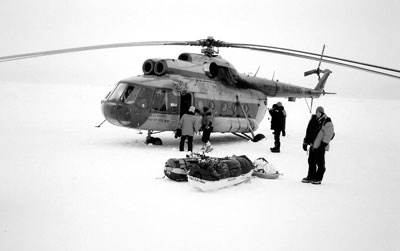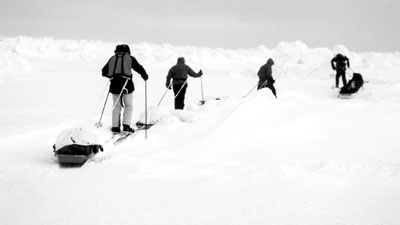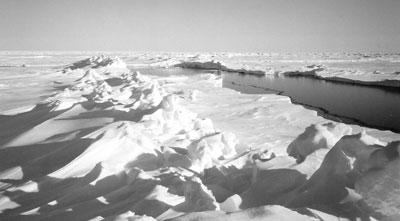Skiing to the North Pole — at 73
by Henry Linden, Torrance, CA
I love to travel. Since I have visited about 75 countries, I am constantly on the lookout for new and unusual experiences.
About a year ago I was thinking about going to the island of Spitsbergen in the Svalbard archipelago, located between Greenland and Norway, to get an idea of what it is like to live in an Arctic region. I contacted travel agencies in the town of Longyearbyen in Spitsbergen, and they sent me brochures on what they had to offer on activities and tours in Svalbard.
In the Svalbard Wildlife Service brochure I found something which sounded very exciting to me: a ski expedition to the North Pole.
Passing the test
I did know that it was possible to go to the North Pole on the Russian nuclear-powered icebreaker Yamal from Murmansk in northern Russia, but to sit in the comfort of a ship as it breaks a path through the ice pack to get to the North Pole and then only stay there for one or two hours to sip some champagne and take a few pictures did not interest me. What intrigued me was to be able to ski to the “top of the world” and then camp there for two or three nights and experience the bitter cold temperature and sights of the polar region.
The leader of the ski expedition was a Norwegian, Børge Ousland, who is one of the very best “polar explorers” in the world. He has a long and impressive merit list and has traveled several times to both the North and South poles as well as to the polar areas of Greenland.
I contacted Børge to inquire about the tour, and he had a few questions to ask me to find out if I was fit for the expedition. One question was about my age. When he asked me how old I was and I answered that I was 73, he laughed and said, “Are you kidding me?” I said, “No.”
Then Børge said, “Do you really think that you are in the kind of physical condition to take a trip like this?”
I answered, “Sure,” adding that when I was 61 years old I climbed Mount Kilimanjaro in Africa, which is 19,340 feet high, and since then I had climbed to the summit of seven of the highest mountains that various countries like Russia and Japan have to offer. (What I did not tell him was that I had a hip replaced five months earlier.)
Life in Svalbard
Based on my answers, Børge agreed to let me go on his expedition, so on April 16th I left Los Angeles and flew to Oslo, Norway, via Amsterdam. I spent one night in Oslo, then continued the following day with a flight to Longyearbyen on the island of Spitsbergen, some 800 miles north of the Arctic Circle.
Years ago the people of Svalbard were primarily employed in mining activities on the island, but as the mineral deposits were depleted the mines began to shut down and unemployment increased. As a result, a decision was made to shift direction and focus on tourism to keep the people employed. In the wintertime, it’s skiing and snowmobile trips with overnight camping. In summertime, it’s hiking and boat tours where you can see polar bears, walruses, puffins, birds, etc.
There are roughly 2,000 polar bears in Svalbard. Because they are an endangered species, they are protected and are allowed to roam most anywhere — in the wild and sometimes in the populated areas of the islands.
Every year, two or three polar bears have to be shot in order to protect an individual from a threatening bear. For that reason, every family has its cache of firearms. It is not unusual to see an individual with his weapon slung on his back while shopping in town. And where else in the world can you go into a bank with a rifle hanging on your shoulder or have a pistol on your belt and nobody pays any attention to you?
Eating in Longyearbyen may present the newcomer with a different kind of problem. At the Funktionermesse Restaurant I had polar bear meat for an appetizer and whale and seal meat for the main course.
Polar bear meat is very carefully inspected for the toxic trichina parasite; however, the restaurant cannot give a 100% guarantee that there isn’t any trichina in the meat. Therefore, before you eat the meat you have to sign a paper that you agree to eat it at your own risk. The meat was good and tasted almost like beef.
Skiing adventure
On April 22nd we started our expedition to the North Pole. Our group consisted of six people: two Englishmen, one Italian, one guide, the expedition leader (Børge) and me. All of the others were half my age.
We flew out of Longyearbyen on a Russian Antonov 74 jet to Borneo, a Russian camp approximately 70 miles from the North Pole on the Arctic ice cap. This flight took over two hours. The Russians had made a landing strip on the ice cap by bulldozing the snow off a strip of ice.
After the plane landed, we unloaded our gear and boarded a waiting M18 Russian helicopter that took us closer to the Pole. After the helicopter landed and our supplies were unloaded, our first task was to melt some snow to fill our thermoses with warm water prior to skiing the last leg of our journey to the Pole. All of us had to tow a sled that contained our individual tent, sleeping bag, mattress, food and other items.
The ice along the way was covered with one to two feet of snow. There was also drift snow, hard snow and very uneven surfaces. We had to navigate between leads and pack ice, and the temperature was around -30°F.
The Arctic ice cap itself is like a giant pancake 1,000 miles in diameter. Because the ice cap is not connected to a land mass, it floats in the sea which surrounds it. At the North Pole, the water depth under the ice cap is more than 12,000 feet. The current and the wind move the position of the ice cap constantly.
Setting up camp
After skiing for nine hours, we arrived at the “top of the world.” The location (90 degrees north) was carefully checked with GPS to verify our location.
We arrived at the North Pole by 11 p.m. — in bright daylight. During that time of the year, the sun never sets and is a minimum of 20 to 25 degrees above the horizon all day. We put up our tents and had something to eat before we bunked down in our sleeping bags and tried to go to sleep in the light.
During the first day we had poor visibility, but the following day we had a clear sky and, because of that, a lower temperature (-35°F). During the time we camped, the ice had drifted about one mile, so our camp was no longer exactly at the North Pole.
We stayed at the Pole for three days in order to ski and survey the area. Our leaders had put on a demonstration on how to survive in open water and at the same time maneuver a sled with its gear around the ice floe.
I have visited many wonders around the world, but I have found the Arctic and Mount Kilimanjaro to be the most interesting and majestic sights I have experienced.
Trip details
The cost of this 5-day trip — Longyearbyen-North Pole-Longyearbyen — is NOK88,500 ($13,387). This included skis, ski boots, camping equipment and food. For more information, contact Børge Ousland (phone +47 22285417 or visit www.ousland.com).
Svalbard Wildlife Service (Nœringsbygget, Pb 164 9171 Longyearbyen; phone +47 7902 5660 or visit www.wildlife.no) offers two other options to the North Pole, as well. The first is a 10-day ski/camping trip; the other is an airplane/helicopter trip (no skiing involved), which drops you at the North Pole for two to three hours before returning.




